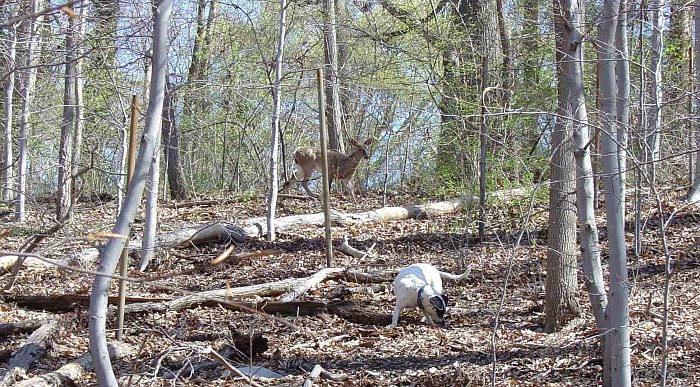

Invasive Plants and RIP
Deer
Does Sligo Have Too Many Deer?
The question is worth asking because nearly everyone has seen deer in the park, and property owners have found them nibbling in yards. Deer generally prefer native plants, which they evolved with, to non-native plants. Deer eat buds of multiflora rose, but not enough to keep rose from spreading.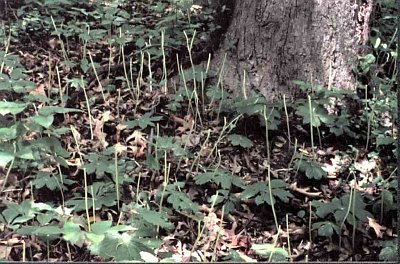
Following are excerpts from an article by Scott Aker in the Washington Post, Jan. 12, 2006.
"The deer population is certainly one of the most imbalanced parts of our forest ecosystem in the mid-Atlantic region. Deer begin to degrade woodland plant communities when they reach a density of 15 to 20 deer per square mile. Population densities of 30 to 40 deer per square mile are not uncommon in our area.Deer population densities are likely to remain very high because their main predators are excluded and hunting is not allowed in populated suburban areas.
Unfortunately, simply planting the seeds of woodland plants will not bring them back. If the deer population is high, these new plants will be browsed into oblivion.
Ecosystem repair requires a holistic approach. Invasive plants must be removed, and a means to limit the deer population in these areas must be devised if the character of our woodland plant communities is to be restored. Simply combating part of the problem by removing invasive plants will have little effect on the results, just as simply reducing the deer herd will not bring back the natives, particularly if the effort is not ongoing."
Determining Whether Deer are a Problem
Deer may well be creating an imbalance in Sligo Creek Park, but only a professional count (filming by plane or helicopter with infrared in winter, or filming in daylight against the snow) will give an objective answer. The Park has no plans for such a study in our half square mile of park, though in 2006 it will begin a deer management program at Wheaton Regional Park. Possibly any deer pressure in Sligo will be relieved by the deer moving into Wheaton.Methods exist to informally assess how much damage deer are causing. Is there evidence of a browse line in the woods - a point four to six feet from the ground, below where there is no vegetation? Is the forest floor nearly barren of green vegetation? How frequently are tree trunks with deer damage seen? If newly planted trees are not fenced, or the fencing falls, are the trees destroyed by deer? If the answer to the last question is yes, it suggests natural tree seedlings are being lost too.
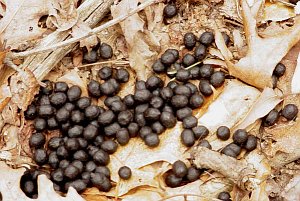
Deer Damage to Trees
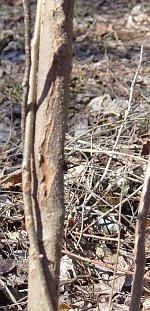
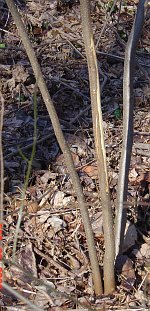
The Browse Line in Kemp Mill, or The Effect of Deer on Birds
In the woods at Kemp Mill a herd of eleven or more deer can often be seen browsing the woods. There is a browse line - no tree branches or leaves exist below deer reach. The only three common plants remaining in the woods are Japanese stilt grass, Japanese honeysuckle, and the native greenbrier, which is tough-stemmed and thorny. How did this gradual loss of plant cover affect wildlife? Ecologist and birder Gail Mackiernan, who lives in the area, spoke at a program meeting in September 2004, and according to meeting notes said, "Birds which used to nest in Sligo Creek Park are the Northern bobwhite quail (lost), the American Redstart (rare), and the Kentucky Warbler (lost). The wood thrush has also been impacted by deer eating the ground cover it needs." With cover gone, birds nesting near the ground have left the woods.Park employee Marty Aument remembers whippoorwillls in Kemp Mill as he grew up. They lay eggs on the ground, and we are uncertain about their need for low vegetation. The loss of whippoorwills may well be due to domestic cats hunting outdoors. Allowing cats loose beyond one's own property, incidentally, is illegal in Montgomery County.
Tree Fencing
The Park shields new trees from deer because the likelihood of damage is high. Putting a stake and wire fencing around each tree nearly doubles the cost and time required. In a sense it seems absurd to cage every tree rather than to address source of the problem. Wire cages protect fairly well, better than the white plastic spiral wrap-arounds once used on trunks.Deer Exclosures
In 2004 Friends of Sligo Creek, with Park help, erected two deer exclosures in sections 6 and 9. We are comparing the number and variety of native plants that grow outside the fencing and inside, where deer cannot browse. See the Action Log entry Building Deer Exclosures for Park & Planning.Principles for Selecting Trees for Deer-Proofing
To BeginYou have to recognize tree species, or at the VERY LEAST, invasive trees, so as not to mark the wrong ones for caging.
Where
Start with all rare and uncommon tree species. Consult the Native Plant Inventory by section. These trees should definitely be caged first.
Then decide on the stretch where you most want to preserve trees. Consider the paved path, dirt paths, along the creek, or in the woods. Mark off an area mentally - between two bridges, from playground to a street, etc. Or arbitarily start along the Trail at one end of the section.
Distance and Size of Trunk
Try to flag some tree every 15-20 feet or so. If nothing suitable exists, make notes for planting a tree there in the future. Don't cage trees that are within 10-15 feet of each other unless both seem exceptionally important to save.
There is no need to cage trees 4 inches in diameter. Carole Bergmann, Principal Natural Resources Specialist of Montgomery County Parks, says only trees up to 3 inches or so are likely to be buck-rubbed.
Species
Select the trees that provide high-value food for wildlife - oak, walnut, hickory, and cherry if it isn't too common. Oak trees are nearly top of the list - acorns are high in food value and are produced in quantity. An oak needs 25 years before it produces acorns. Hickory cannot readily be transplanted, so protection seems equally important. Walnut, cherry are good - we need some of everything. In section 8 there are many tall tulip poplar trees, but one doesn't run across a single young one available for protecting. Tulip now is high on the list in that area.
Incidentally, yellow buckeye should not be saved. It was introduced by the Park from farther west, and is said to be disliked by wildlife. These trees are spreading rapidly in some sections.
Shrubs are worth looking at. Spicebush is already ubiquitous, but if you find maple-leaved, arrowwood viburnum, or blackhaw, they're worth saving.
The Park's Natural Resources Department strongly supports our efforts to save trees, and will provide materials and know-how. Contact Carole.Bergmann@mncppc-mc.org A final list of trees that are deer-protected should be sent to Carole Bergmann at Carole.Bergmann@mncppc-mc.org and to the FoSC Natural History Chair at naturalhistory@fosc.org for records.
Deer as a Likely Explanation for Yellow Buckeye Invasion
See the web page Horticultural Areas along the Parkway.
